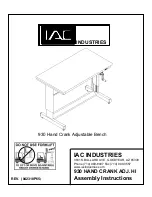
Because
the
cables,
connectors,
and
terminators
are
the
same
for
the
Ultra160
and
Ultra2
SCSI
interfaces,
devices
with
those
interfaces
can
be
mixed
on
the
same
bus
and
each
device
can
operate
at
its
fully
rated
speed.
Address
Assignments
Each
device
on
a
SCSI
bus
must
have
a
SCSI
identifier
(ID)
that
allows
the
server
to
recognize
it.
For
more
information,
see
“Set
the
SCSI
ID
or
Arbitrated
Loop
Physical
Address”
on
page
15.
Installing,
Removing,
or
Resetting
a
Drive
on
an
Active
SCSI
Bus
You
can
attach
a
drive
to
an
active
SCSI
bus.
However,
the
preferred
and
safest
method
of
adding,
removing,
or
resetting
a
drive
is
to
power-off
the
system.
To
add,
remove,
or
reset
a
drive
on
an
active
SCSI
bus:
1.
Quiesce
all
drives
on
the
SCSI
bus.
The
drive
to
be
added,
removed,
or
reset
must
not
be
involved
in
any
bus
activity.
2.
Disconnect
power
to
the
drive.
3.
Connect
(to
install)
or
disconnect
(to
remove
or
reset)
the
SCSI
bus
cables
to
or
from
the
drive’s
SCSI
connector.
Ensure
that
the
SCSI
bus
remains
intact
from
the
server
(initiator)
to
the
terminator
throughout
the
connection
or
disconnection
process.
Note:
Changing
or
moving
the
terminator
disrupts
the
continuity
of
the
SCSI
bus
and
interrupts
any
process
on
the
bus.
Fibre
Channel
Interface
Attention:
A
Class
I
laser
assembly,
in
the
optical
transceiver,
is
mounted
on
the
Ultrium
Fibre
Channel
electronics
card.
This
laser
assembly
is
registered
with
the
Department
of
Health
and
Human
Services
and
is
in
compliance
with
IEC825.
To
communicate
with
a
server,
the
drive
has
one
Fibre
Channel
interface
(also
called
a
port
).
In
accordance
with
the
standards
of
the
American
National
Standards
Institute
(ANSI),
the
port
runs
Fibre
Channel
Protocol
(which
includes
SCSI
commands
on
the
Fibre
Channel)
with
ANSI-defined
Fibre
Channel
Tape
Support.
The
method
by
which
the
drive
and
server
communicate
is
determined
by
the
type
of
topology
in
which
they
reside
and
the
type
of
connection
that
you
choose.
Supported
Topologies
The
drive
can
be
attached
in
a
two-node
configuration,
either
directly
to
a
switch
as
a
public
device
(switched
fabric)
or
directly
to
a
host
bus
adapter
(HBA)
as
a
private
device.
It
can
do
so
in
a
Point-to-Point
topology
(through
an
F_port)
or
Arbitrated
Loop
topology
(through
an
L_port
or
FL_port).
Unless
you
set
the
drive
to
force
an
explicit
configuration
(by
using
the
FC
configuration/status
connector;
see
“Change
the
Link
Services
of
the
Drive
(optional)”
on
page
21),
the
drive
automatically
configures
to
an
L_port
or
an
Product
Description
7
|
||
||
|
|
|
|
|
|
|
|
|
|
|
|
|
|
|
|
|
|
|
|
Summary of Contents for TotalStorage Ultrium T800
Page 2: ......
Page 8: ...vi IBM TotalStorage Ultrium Tape Drive...
Page 10: ...viii IBM TotalStorage Ultrium Tape Drive...
Page 14: ...xii IBM TotalStorage Ultrium Tape Drive...
Page 16: ...xiv IBM TotalStorage Ultrium Tape Drive...
Page 28: ...12 IBM TotalStorage Ultrium Tape Drive...
Page 88: ...72 IBM TotalStorage Ultrium Tape Drive...
Page 108: ...92 IBM TotalStorage Ultrium Tape Drive...
Page 124: ...108 IBM TotalStorage Ultrium Tape Drive...
Page 126: ...110 IBM TotalStorage Ultrium Tape Drive...
Page 130: ...114 IBM TotalStorage Ultrium Tape Drive...
Page 147: ......
Page 148: ...Printed in USA GC26 7697 01...
















































